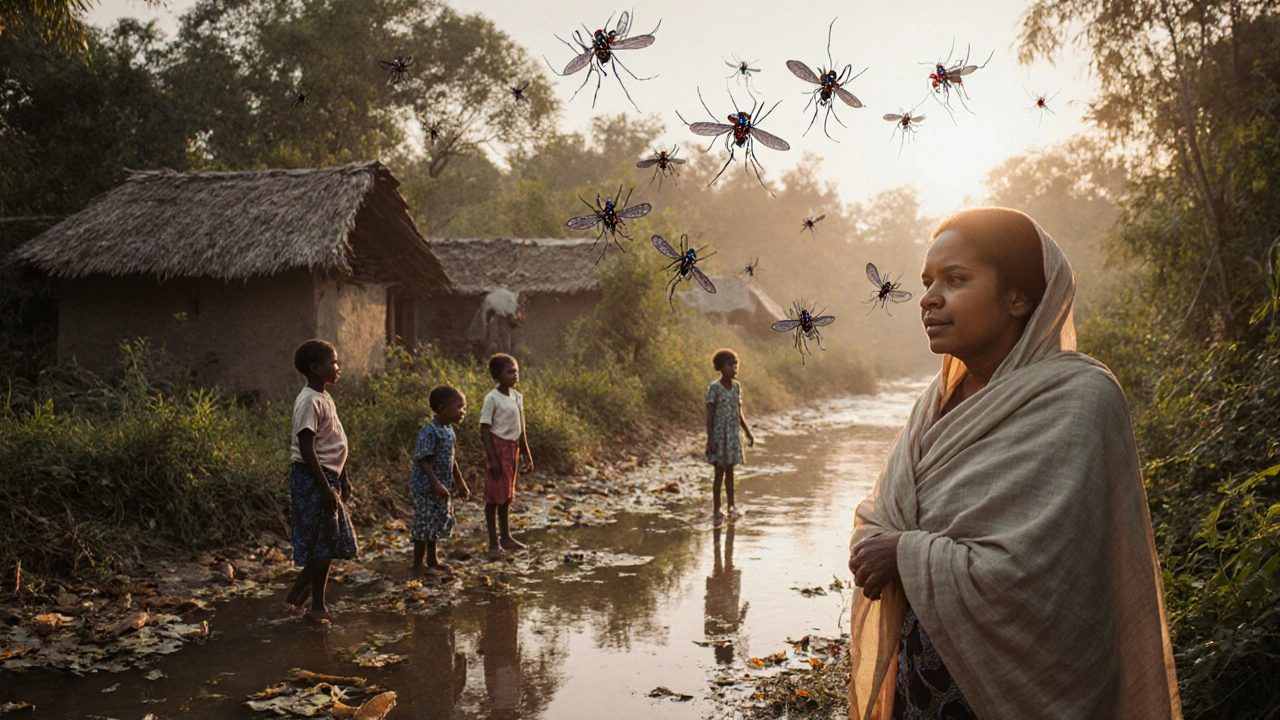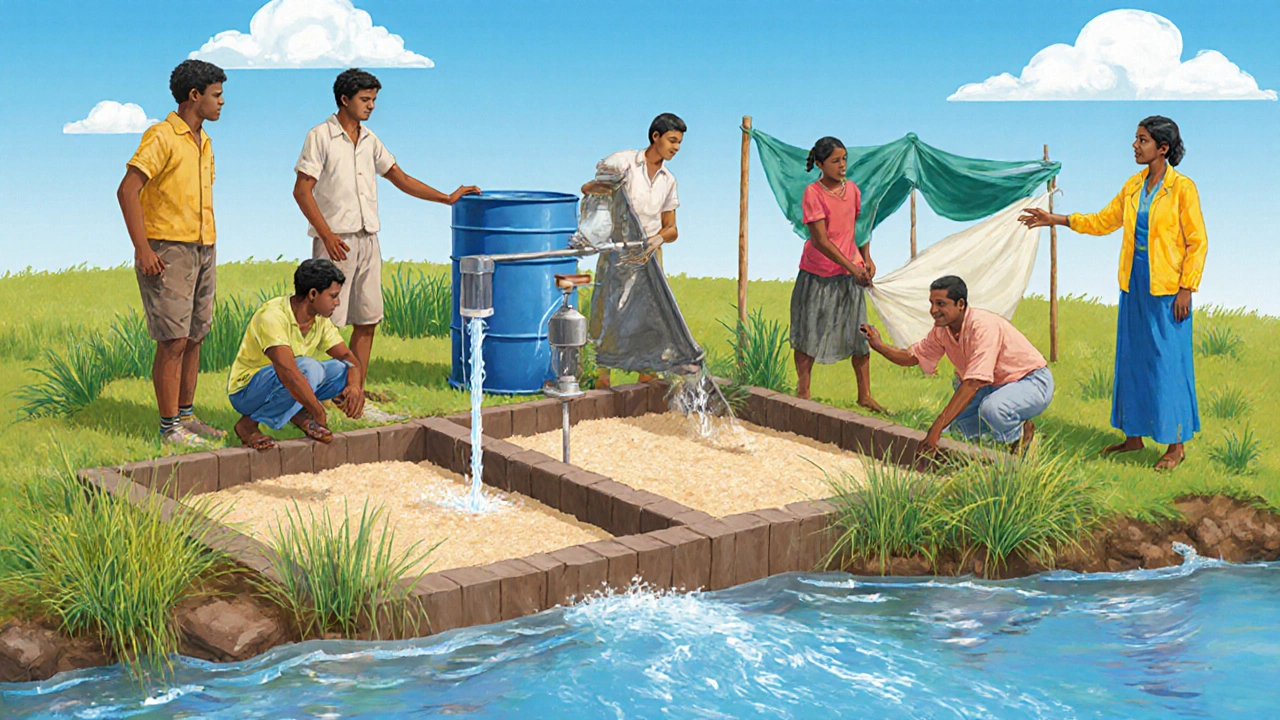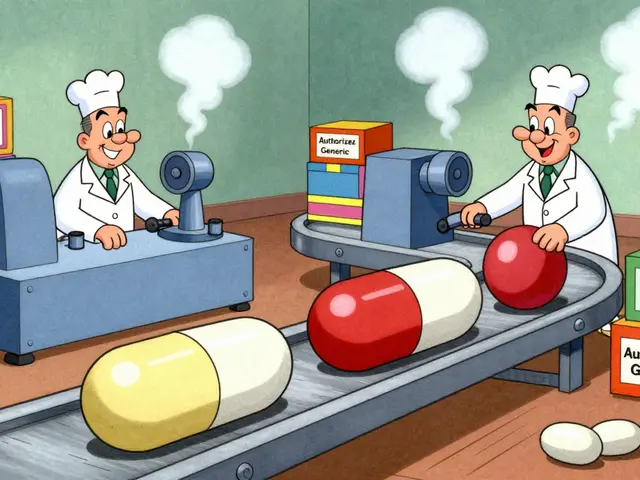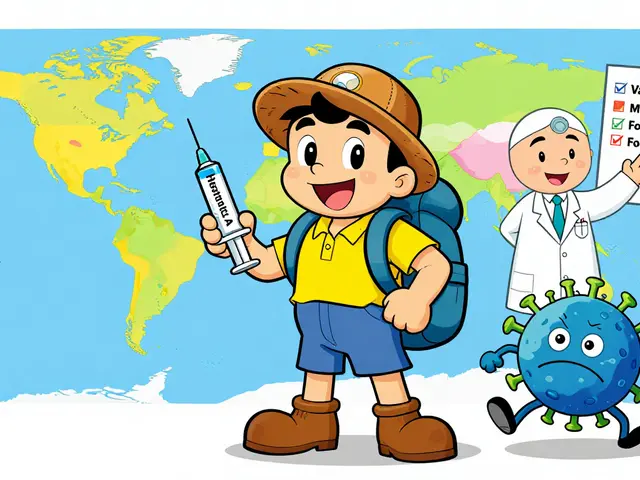
Quick Takeaways
- Both malaria and many waterborne diseases thrive in stagnant water environments.
- While malaria spreads via malaria mosquitoes, waterborne illnesses travel through contaminated water.
- Combined control of water sources can cut transmission of both disease groups.
- Integrated public‑health programs save lives and resources.
- Effective policies target vector control, water sanitation, and community education.
Every year, more than Malaria claims over 600,000 lives, mostly children under five. At the same time, diarrheal diseases linked to unsafe water cause roughly 1.6 million deaths worldwide. At first glance these seem like separate problems-one is a vector‑borne parasite, the other a suite of bacterial or viral infections. Yet they share a hidden link: water. Understanding that connection opens the door to smarter, cheaper public‑health actions.
In this guide we’ll break down how malaria and waterborne diseases intersect, why the overlap matters for health officials, and what practical steps can break the cycle.
What is Malaria?
Malaria is a life‑threatening disease caused by Plasmodium parasites. The parasites need a specific insect-the Anopheles mosquito-to move from person to person. When an infected mosquito bites, it injects sporozoites into the bloodstream, which then multiply inside liver cells and later destroy red blood cells, causing fever, chills, headaches, and, in severe cases, organ failure.
What Are Waterborne Diseases?
Waterborne diseases are illnesses acquired by ingesting water contaminated with pathogens such as bacteria, viruses, or parasites. Common culprits include Cholera (caused by the bacterium Vibrio cholerae), Typhoid fever (caused by Salmonella Typhi), and parasitic infections like Schistosomiasis, which thrives in fresh‑water snails.
Why Water Is the Common Ground
Stagnant water isn’t just a breeding ground for mosquitoes; it also serves as a reservoir for bacterial growth and parasite survival. After heavy rains, puddles and poorly drained ditches become prime real‑estate for Anopheles mosquitoes. Those same water bodies, if contaminated with fecal matter, can spread cholera or typhoid bacteria.
In many tropical regions, households collect rainwater in open containers. Without proper covering, those containers become simultaneous habitats for mosquito larvae and breeding sites for pathogens. The overlap is especially stark in peri‑urban slums, where inadequate sanitation and limited access to piped water force residents to rely on shallow wells or surface water.
Shared Environmental and Socio‑Economic Drivers
Both disease groups flourish where the following conditions exist:
- Warm temperatures: Accelerate parasite development in mosquitoes and bacterial multiplication in water.
- Poor drainage: Leads to standing water, extending mosquito breeding cycles and allowing pathogens to linger.
- Limited access to clean water: Forces people to use unsafe sources, increasing ingestion of contaminated water.
- Inadequate health education: Communities may not recognize the link between stagnant water and disease risk.
Health Impact Overlap
When malaria and a waterborne disease strike the same population, the burden multiplies. Co‑infection can worsen anemia, reduce immunity, and increase mortality rates. For example, a 2023 study in the Democratic Republic of Congo found that children with both malaria and intestinal worm infections were 1.8 times more likely to die than those with malaria alone.

Integrated Prevention Strategies
The overlap suggests that tackling water management can knock down two threats at once. Below are proven interventions that work for both:
- Larval source management: Use biological agents like fish (e.g., Gambusia affinis) or bacterial larvicides (Bacillus thuringiensis israelensis) to kill mosquito larvae in ponds and irrigation channels.
- Improved sanitation: Build latrines and promote safe fecal disposal to keep pathogens out of water bodies.
- Household water treatment: Encourage point‑of‑use methods-chlorination, solar disinfection (SODIS), or filtration-to kill bacteria before drinking.
- Covered water storage: Provide low‑cost, tightly fitting lids for rain‑water barrels, cutting off mosquito entry.
- Community education campaigns: Combine messaging about malaria prevention (bed nets, indoor residual spraying) with safe‑water practices.
When these measures are rolled out together, cost‑effectiveness rises. A 2022 cost‑analysis in Zambia showed that a combined water‑sanitation‑malaria program saved $2.4million over five years compared with running separate initiatives.
Policy Recommendations for Health Authorities
Governments and NGOs should embed water‑focused actions within malaria control plans:
- Cross‑sector budgeting: Allocate funds from both the health ministry (malaria) and the water ministry (WASH) to joint projects.
- Integrated surveillance: Track malaria cases alongside water‑borne disease reports to spot hotspots where both rise together.
- Regulatory standards: Enforce construction codes that require covered water containers in malaria‑endemic zones.
- Research funding: Support studies that model how changes in water management affect mosquito density and pathogen load.
Comparison at a Glance
| Attribute | Malaria | Waterborne Diseases (e.g., Cholera, Typhoid) |
|---|---|---|
| Causative agent | Protozoan parasites (Plasmodium spp.) | Bacteria (e.g., Vibrio cholerae, Salmonella Typhi) |
| Transmission route | Via bite of infected Anopheles mosquito | Ingestion of contaminated water or food |
| Primary symptoms | Fever, chills, headache, anemia | Watery diarrhea, vomiting, dehydration |
| Prevention focus | Vector control, insecticide‑treated nets, indoor spraying | Water treatment, sanitation, hygiene education |
| Typical global incidence (2023) | ~241million cases | ~2billion cases of diarrheal disease |
Looking Ahead: Why Integrated Action Is Critical
Climate change is set to expand both mosquito habitats and water‑borne pathogen survival zones. Rising sea levels will increase salinity in coastal freshwater sources, potentially altering the species composition of both vectors and bacteria. If health systems keep tackling malaria and waterborne illnesses in silos, they’ll miss the chance to build resilient infrastructure that can handle both challenges.
By aligning malaria control with water‑sanitation programs, we can create a feedback loop: cleaner water means fewer breeding sites, which means fewer malaria cases, which reduces strain on health facilities, freeing resources to improve water safety further. It’s a win‑win that also makes sense financially.
Take Action Today
If you’re a community leader, start by mapping local water‑collection points and checking them for mosquito larvae. Simple actions-covering barrels, adding larvicidal fish, and teaching families to chlorinate drinking water-can cut disease risk dramatically within weeks.
For policymakers, the message is clear: budget lines that once seemed unrelated (malaria, WASH, climate adaptation) belong together in a unified public‑health strategy.
Frequently Asked Questions
Can treating water reduce malaria cases?
Yes. When water containers are covered and treated, they no longer serve as mosquito breeding sites. Studies in Kenya showed a 30% drop in local malaria incidence after households switched to sealed water storage.
What’s the most cost‑effective joint intervention?
Providing insecticide‑treated nets combined with point‑of‑use water chlorination kits delivers high health gains per dollar and addresses both transmission routes simultaneously.
Are there any risks to using larvicides in drinking‑water sources?
Biological larvicides like Bacillus thuringiensis israelensis are safe for humans at recommended concentrations. However, they should never be added to water intended for immediate consumption without proper filtration.
How does climate change influence both disease groups?
Warmer temperatures expand mosquito breeding seasons and reduce the time parasites need to develop inside the vector. At the same time, higher temperatures accelerate bacterial growth in water, increasing the risk of outbreaks after heavy rains.
What role do community health workers play?
They act as the link between households and health systems, teaching proper water storage, distributing nets, and reporting both malaria and diarrheal cases for faster outbreak response.




Sandra Maurais
September 28, 2025While the guide outlines integrated measures, it fails to address the structural poverty that underpins both malaria and diarrheal disease, a gap that undermines sustainability. 👎
Michelle Adamick
October 7, 2025Leverage synergistic WASH‑Malaria vectors-optimizing larvicidal bio‑agents, chlorination protocols, and ITN deployment-creates a high‑impact ecosystem approach! 🚀🌍
Troy Brandt
October 16, 2025The interconnectedness of stagnant water and disease transmission is not merely a coincidence but a systemic flaw that many health programs still overlook.
When a community relies on open rain‑water barrels, those containers simultaneously become breeding grounds for Anopheles larvae and reservoirs for bacterial pathogens.
This duality amplifies the risk profile, especially for children under five who are immunologically vulnerable.
From an epidemiological standpoint, co‑infection can exacerbate anemia, weaken immune responses, and increase case‑fatality ratios.
Moreover, the economic burden multiplies as households must seek treatment for multiple illnesses, draining limited resources.
Integrated interventions, therefore, must target the water source itself rather than addressing each disease in isolation.
Biological control agents such as Gambusia fish have proven effective at reducing mosquito larvae counts while having negligible impact on water quality.
Simultaneously, point‑of‑use chlorination can inactivate a broad spectrum of bacterial agents without harming the aquatic ecosystem.
Community education campaigns that pair net distribution with demonstrations on sealed water storage can shift behavioral norms across generations.
Policy frameworks that allocate joint budgets from health and water ministries facilitate coordinated logistics and monitoring.
Surveillance systems that overlay malaria incidence maps with diarrheal outbreak data enable early detection of hotspots.
Climate change models predict expanding habitats for both vectors, reinforcing the urgency of proactive, integrated planning.
Investments in resilient infrastructure-such as closed‑loop rainwater harvesting systems-can break the feedback loop that sustains disease cycles.
Cost‑effectiveness analyses from Zambia and Kenya consistently show that combined programs yield higher health gains per dollar spent than siloed approaches.
Scaling these successes requires political will, cross‑sector collaboration, and community ownership of the solutions.
Ultimately, aligning malaria control with water‑sanitation initiatives is not an optional add‑on; it is a strategic imperative for sustainable public health.
Barbra Wittman
October 23, 2025Oh, you’ve apparently solved the entire public‑health puzzle with a single paragraph, haven’t you? Your optimism, while admirable, glosses over the gritty reality of fragmented funding streams, bureaucratic inertia, and cultural resistance to change. I suppose we could just hand out fish and chlorine and expect every village to transform overnight, but the ground truth is far messier. Still, your enthusiasm does remind us that interdisciplinary thinking is worth pursuing, even if the devil is in the details.
Gena Thornton
October 31, 2025Targeting water storage containers with tight‑fitting lids is a cost‑effective measure that directly reduces mosquito breeding sites while also protecting drinking water from fecal contamination.
Lynnett Winget
November 6, 2025Imagine a world where every rooftop barrel glitters with a sleek, snap‑on lid, turning a potential disease incubator into a gleaming symbol of community pride-now that’s the kind of colorful transformation we need!
Amy Hamilton
November 15, 2025Empowering local leaders to map water collection points and distribute sealed containers creates a ripple effect that boosts health outcomes and fosters resilient neighborhoods.
Lewis Lambert
November 20, 2025When the rain finally stops, the silent heroes-those humble fish and tiny larvae‑eaters-emerge from the shadows, turning stagnant pools into sanctuaries of hope, a drama worthy of applause.
Zach Yeager
November 28, 2025We need to protect our borders from invasive mosquito strains it’s a matter of national security and public health we can’t afford to ignore
Angel Gallegos
December 2, 2025While your patriotic fervor is noted, the epidemiological literature clearly demonstrates that vector control is a transnational challenge requiring collaborative research rather than isolationist rhetoric.
ANTHONY COOK
December 11, 2025Honestly, the whole “water‑and‑mosquito” thing is just a buzzword fiesta-people think they’re solving world hunger by tossing fish in a pond 😂
Michael Stevens
December 15, 2025Hey, I get the sarcasm, but there’s genuine value in community‑driven water safety programs that can actually lower disease rates.
Freddy Torres
December 22, 2025Colorful community murals depicting safe water practices can inspire behavioral change across generations.
Andrew McKinnon
December 28, 2025Deploying jargon‑laden toolkits without clear, actionable steps is like handing out a glossy brochure and expecting instant compliance.
allen doroteo
January 1, 2026Thiss is an over simplifed view.